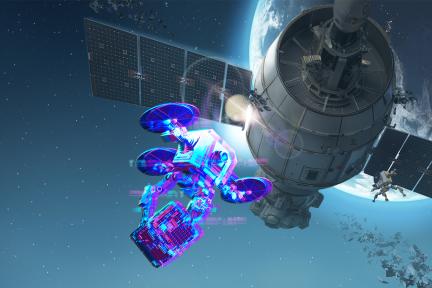Jason: ISAM covers many capabilities, but the acronym stands for “In-Space Maintenance, Assembly and Manufacturing.” You may have heard of OSAM in orbit, but ISAM has emerged as the mainstream term. But there’s also a key unspoken task to this ISAM effort: we need to identify and track objects in space. This domain is known as space situational awareness, and we’ve been doing this since the beginning of our space foray.
Going into space is a bit of a tricky business. We leave a lot of debris behind, whether it’s rocket bodies, other space objects, or man-made objects. So any Space Situational Awareness (SSA) mission now has to do Active Debris Removal (ADR). These are the implicit tasks beyond ISAM.
In this SSA, you need to know what is in the physical space you want to use. Currently, there is a lot of attention on removing orbital debris and creating a sustainable space environment without increasing debris. So technologies like reusable rockets help to reduce debris as well as manage the space that you are using. But with space situational awareness, you can “see” what is in the environment and perform maintenance on your satellites, such as inspecting, repositioning, or replenishing them.
Sabrina: Wow, imagine a day when servicing a spacecraft or satellite would be as easy and efficient as refueling a car or repairing a ship. It would feel like my space movies were coming true.
Jason: Absolutely. We’re not there yet, but we have a long way to go. The capability to assemble and manufacture structures and spacecraft in space is definitely moving from science fiction to reality. There have been government-funded experiments on the space station for years to explore manufacturing in space. The private sector is now offering these capabilities commercially, greatly expanding the space economy. Our technology is advancing to make these capabilities in space affordable, practical and profitable.
Sabrina: That’s great! Space technology continues to advance. The word “servicing” appeared in NASA’s technical lexicon only 60 years ago. Then, in the 1990s, the term “satellite servicing” started appearing. So, it seems like ISAM isn’t an entirely new concept here, but there’s a renewed interest and investment in the field, driven by a maturing vision of a modern space economy.
Jason: Yes, absolutely. It was implemented in the early days of space flight and continued in the Space Shuttle program, and space station programs like Mir, Skylab, and today’s International Space Station (ISS), but they were not affordable and the technology was prohibitively expensive to use.
The Technology Maturity Levels (TRLs) for ISAM requirements are now known and investments are being made to further improve the TRLs required for space infrastructure and the space economy. Looking at technology maturity, servicing and assembly mission capabilities are near term, i.e. within 5 years, while manufacturing is a longer term capability, i.e. beyond 5 years.
Sabrina: The question is, why now?

